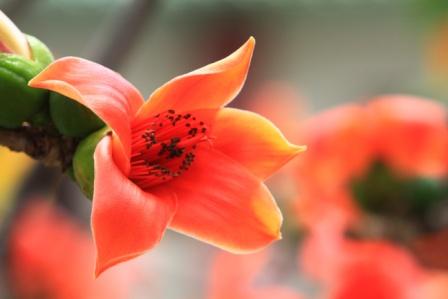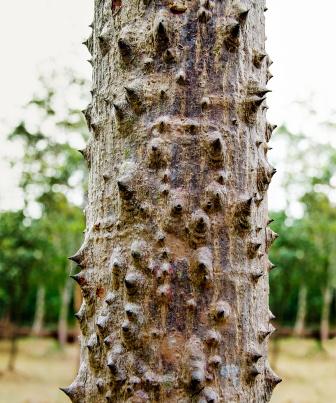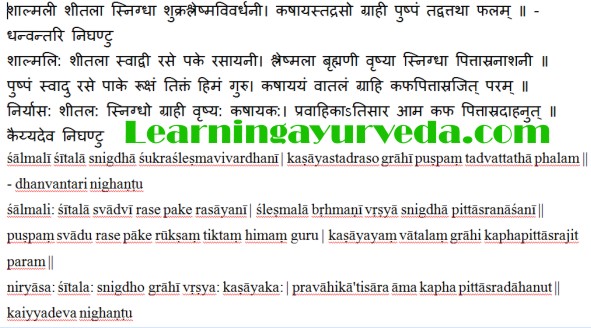Shalmali, Silk Cotton Tree: Ayurveda Use, Medicines, Home Remedies
Shalmali is one of the very useful Ayurvedic herbs, used for thousands of years. Its botanical name is Salmalia malabarica.
Bombax ceiba and bombax malabaricum are also its synonyms.
It belongs to bombocaceae family (Salmali kula).
Table of Contents
Synonyms
Sanskrit Synonyms:
Kantakadya (has thorns) – branches are studded with prickles
Picchila – Juice released by Salmali is sliy
Poorani – Juice is slimy
Bahuvirya – Salmali is very efficacious drug
Mocha – Salmali releases juice which is called mocha
Raktapushpa (red flower)
Sthirayu
Tulaphala – Fruit has cotton like substances
Manadruma, Shirajivika – Salmali is a tall and long lived tree

Vernacular names
Assamese – Tula-goch, Simul, Himila, Himolu, Simolu
Bengali – Roktosimul, Katseori, Shimul
English – Kapok tree, Red Cotton Tree, Indian bombax, Red silk cotton tree, Silk Cotton, Malabar Semul, Silk Cotton Tree
Gujarati – Safed Shimalo HinShimal, Simal
Hindi – Shimbal, Semal, Simul, Semur, Simal, Rakta Senbal, Simal, Semar Kanda, Shembal, Kaantisenbal, Semul
Kannada -Proparte, Booraga, Sauri, Burla, Kemphuburuga, Kempuburuga, Burga, Pula, Booragada Mara
Malayalam – Kandilavu, Unnamurikku, Ilav, Puula, Panjimaram, Poorani, Mocha, Mullilavu, Ellavu, Illavu, Elavu, Pichila, Mulalilav, Poola, Pulamaram, Poola, Ilavu
Manipuri – Tera
Marathi – Saanvari, Saanvar, Shaalmali, Saura, Shembalsavari
Oriya – Similikonta
Tamil – Mullilavu, Ilavu Maram, Mull Ilavu, Pulai, Mullilavu, Puulaa, Purani, Ilavu, Elava Maram, Moul Elavou, Malai Elavam
Telugu – Buruga
Varieties
Bh. pr. Ni
Salmali – Salmalia malabarica
Kuta salmali – Ceiba pentandra
Morphology, Distribution
Salmalia malabarica is a tall deciduous tree. Old trees are often buttressed. Trunk is straight and there are numerous conical prickles on branches and trunk. Leaves are digitate and arranged alternately. Leaflets are 5-7 in number, oblanceolate in shape and glabrous. Flowers are large, red or sometimes white in color, present near the end of branches either solitary or in clusters. Fruit is a woody cylindrical capsule enclosing numerous, smooth, dark brown seeds which are embedded in white silky fibers.
Distribution
Salmalia malabarica is grown mainly in Southern China, India and Northern Australia
Classical categorization, History
Charaka
Pureesha Virajaniya – Group of herbs that imparts natural color to feces
Shonitasthapana – Group of herbs that check bleeding, improves blood quality and quantity.
Vedanasthapana – Analgesic group of herbs.
Kashayaskanda – Astringent group of herbs.
Sushruta – Priyangvadi
History: In Rigveda, Shalmali wood was used to prepare chariots during marriage rituals.
Part used, Dose
Part used: Flower, gum, stem bark, petiole, peduncle and prickles / thorns
Dosage
Stem bark powder – 5 – 10 grams
Flower, Root bark powder – 3 – 5 grams
Juice – 10 – 20 ml
Niryasa ( Exudate) – 1 – 3 g

Thorns are pounded with milk and the paste is applied over pimples.
Its gum exudate is called Mocharasa, which is used in many Ayurveda formulations. It is styptic and hemostatic.
Bombax malabaricum is a large deciduous tree with prickles.
Major chemical constituents
Gum exudates contains gallic and tannic acids.
Bark, root bark, seed contains lupeol. Flowers contain hentriacontane and gossypol.
Pharmacological activities
Bombax_ceiba possesses antioxidant, antimicrobial, anticarcinogenic, anti-inflammatory, immunomodulatory, hypotensive, hypolipidemic, antihyperglycemic, and analgesic activities.
Medicinal properties

Rasa – kashaya – astringent taste
Guna (qualities) – Laghu (light to digest), Snigdha (unctuous, oiliness)
Vipaka – taste conversion after digestion – Madhura (sweet)
Veerya – sheeta – Cold potency
Action on dosha- Vatapitta samaka
Pharmacological Action- Astringent, Styptic, Diuretic, Aphrodisiac
Root, bark, flowers
1. Shalmali root, bark and flower are –
Sheetala – coolant, snigdha (unctuous),
Shukravardhini – improves sperm / semen
Shleshmavardhini – increases kapha.
Its flowers and exudates (Mocharasa) are grahi – absorbents and styptic.
Flower of Shalmali is Grahi (absorbent, useful in diarrhea) and used in treating Raktapitta – bleeding disorders (Charaka Sutrasthana 27)
Root and stem bark
2. Shalmali root and stem bark are –
sheetala (coolant),
svadu (sweet in taste and after digestion),
shleshmala – increases Kapha,
brihmani – improves nourishment of the body,
vrushya – aphrodisiac,
snigdha – unctuous,
pittasranashani – relieves Pitta and bleeding disorders.
Flower
Shalmali flower is
Svadu – sweet
Ruksha – dry
Tikta – bitter
Hima – coolant,
Guru – heavy to digest
Kashaya – astringent
Vatala – Increases Vata
Grahi – absorbant
Kaphapittasrajit – decreases Kapha and bleeding disorders. The curry made with shalmali flowers and added with ghee and rock salt helps to cure pradra.
Shalmali Niryasa – Mocharasa
Sheetala – coolant
Snigdha (unctuous, oiliness)
Grahi – absorbent
Vrushya – aphrodisiac
Kashaya – Astringent
Pravahikahara – relieves diarrhea
Atisarahara – Relieves dysentery and diarrhea
Amanut – Relieves ‘Ama” – a state of indigestion at stomach and tissue level
Kaphahara – balances kapha
Pittasranut – Relieves bleeding disorders
Dahanut – relieves burning sensation
Another herb called Kootashalmali is mentioned as the lower variant of the plant Shalmali.
Remedies
- In blood dysentery, decoction of shalmali stem bark is given mixing along with curd.
- Paste of bark is applied externally to treat boils, acne, pimples.
- In tenesmus, enema prepared with petioles or exudation of shalmali boiled in milk and added with ghee is given. (Charaka Siddhi sthana 10/36)
- Shalmali petioles are kept overnight in cold water. Next morning this cold infusion is consumed with licorice and honey. (Shushrutha uttara sthana 40/98)
- In spleenomegaly, shalmali flowers are well steamed, kept overnight and then it is consumed mixing with rajika powder. (Bhavaprakasha Nighantu 33/18)
- Shalmali thorns are powdered and made with milk paste. This is applied on freckles and pimples.
- Its bark along with milk is used as an aphrodisiac.
- Salmali flowers cooked with ghee and rock salt is used to check bleeding.(Bhavaprakasha Nighantu 9/51)
- Shalmali bark paste is applied over feet relieves burning sensation. This paste is also used to destroy guinea worms.
Interaction with medicines, supplements
Can this be used while taking Homeopathic medicine?
Yes. This product does not react with homeopathic medicine.
Can this medicine be continued while taking supplements like multivitamin tablets, Omega 3 fatty acids etc?
Yes. Generally, this product goes well with most dietary supplements. However, if you are taking more than one product per day, please consult your doctor for an opinion.
With western
medicines
Seek your
doctor’s advice if you are taking this product along with other western
(allopathic / modern) medicines. Some Ayurvedic herbs can interact with modern
medicine.
If both Ayurvedic and allopathic medicines are advised together, then it is
best to take Allopathic medicine first, wait for 30 minutes and then take the
Ayurvedic medicine.
Research, Ayurvedic medicines
Research:
Phytochemical investigations – A study was done to investigate phytochemicals and biological studies of extract of Bombax malabaricum flowers.
Important preparations: Shalmali Ghrita, Chandanasava, Himasagara Tailam
Sthanika Karma (Systemic Action)
External – Bark has Anti inflammatory action. Relieve the burning sensation. Flowers have a styptic action. Resin is wound healing in nature. Thorns have a scraping effect on dhatus and promote complexion. In bleeding conditions powder of the flower can be used for sprinkling on wounds. Resin is useful in mouth ulcers. Latex is indicated for cosmetic purposes. (Indicated in Nyacha, vyanga etc.)
Digestive System – Mocarasa is Absorbent. Useful in Diarrhea, Malabsorption syndrome, Hemorrhoids etc.
Circulatory System – Mocharasa(Resin) and flower is indicated in bleeding disorders.
Respiratory System – Raw fruit is indicated in Cough
Excretory System – Raw fruit powder is highly beneficial in Renal calculi, Dysuria, etc.
Reproductive system – Aphrodisiac. Mocarasa is sukrasthambaka, Flower is Arthavarodhi, indicated in menorrhagia.
Skin – Indicated in Skin disorders
Satmikarana –Indicated in general weakness (Fruit is balya and brimhana)











3 comments
Anant Tarawade
NEEDFUL INFO ABOUT SHALMALI
BHARAT
very good information about shimalo tree
Dr J V Hebbar MD(Ayu)
Thank you.